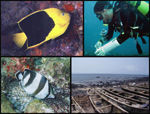
Feeding macroecology and evolution of the Banded Butterflyfish
Chaetodon striatus
CNPq Edital 014/2010 - Proj. no. 483682/2010-1

Fotos: JP Krajewski
The degree of gene flow among populations is defined as genetic connectivity. For the successful establishment of a species with tropical affinities in peripheral (and colder) subtropical areas, it is crucial that, at least, favorable biotic factors, like habitat availability and food resources, are present. The main goal of this proposal is to obtain feeding data (behavior and gut contents) and genetic samples of Chaetodon striatus throughout its distribution range, from south Brazil to Puerto Rico in the Caribbean in order to address the following questions: 1) Are there breaks in genetic population structure between the Caribbean and Brazil, due to the effects of the Amazon and Orinoco outflows? 2) Are these possible genetic differences related to distinct feeding ecology among different reef systems, or do ecological settings drive genetic differentiation among populations (ecological speciation)? and 3) Could the large distribution range (that includes subtropical areas) be explained by plasticity in feeding behavior if no genetic breaks are found? The results will shed light on how connectivity and feeding behavior interplay in the life history characteristics of this species, including: a) food resource selectivity at the macroecological scale and how it is connected with evolutionary processes and b) how genetic diversity is distributed in space along the distribution range of this species (e.g. less genetic diversity is expected in the periphery). (see map below)
